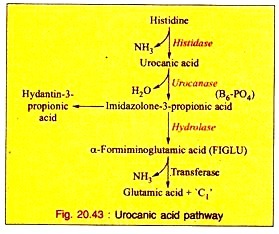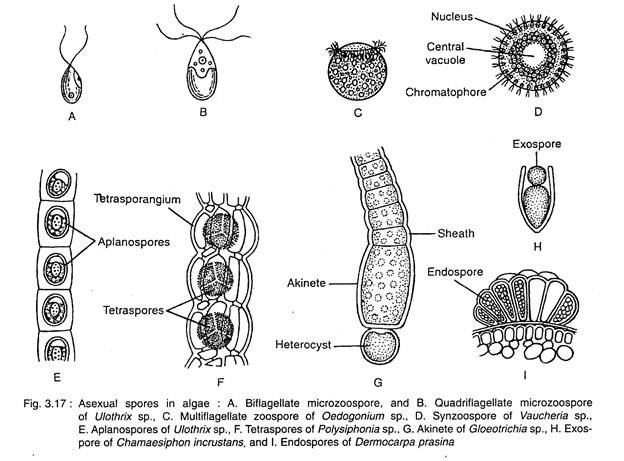ADVERTISEMENTS:
The following points highlight the three modes of reproduction in algae. The modes are: 1. Vegetative 2. Asexual 3. Sexual.
Mode # 1. Vegetative Reproduction:
In this type, any vegetative part of the thallus develops into new individual. It does not involve any spore formation and there is no alternation of generations. It is the most common method of reproduction in algae.
The vegetative reproduction in algae is of the following types:
ADVERTISEMENTS:
a. Cell division or fission:
It is the simplest method of reproduction. The unicellular forms of algae commonly reproduce by this simple process, often called binary fission as found in Chlamydomonas, Synechococcus (Fig. 3.16A), diatoms etc. In this method the vegetative cell divides mitotically into two daughter cells, those finally behave as new individual.
b. Fragmentation:
In this method, the multicellular filamentous thallus breaks into many-celled fragments, each of which gives rise to a new individual. The fragmentation may be accidental or by the formation of separation discs or by some other mechanical force or injury. It is found in Spirogyra, Ulothrix, Oedo- gonium, Zygnema, Cylindospermum (Fig. 3.16B) etc.
ADVERTISEMENTS:
c. Hormogonia:
This method of vegetative reproduction is found in blue-green algae. The trichomes of blue-green algae break up within the sheath into many-celled segments called hormogonia or hormogones. They remain delimited by the formation of heterocysts, separation discs or necridia or by the death and decay of intercalary cells of the trichome. Hormogonia are commonly found in Nostoc, Oscillatoria, Cylindosporium etc.
d. Formation of Adventitious Branches:
Adventitious branches are formed in different large thalloid algae, which, when detached from the plant body, develop into new individuals (e.g., Fucus, Dictyota). Protonema-like adventitious branches are formed from the internodes of Chara, stolons of Cladophora glomareta etc.
e. Bulbils:
Tuber-like outgrowths are developed due to storage of food at the tip of rhizoids and on the lower nodes of Chara, called bulbils (Fig. 3.16C). After detachment from the plant body, bulbils grow into new plants.
f. Amylum stars:
Star-shaped aggregation of starch containing cells develops on the lower nodes of Chara. These structures are called amylum stars (Fig. 3.16D). When detached from the plant body, they grow into new plants.
ADVERTISEMENTS:
g. Budding:
In Protosiphon bud-like structures are formed due to proliferation of vesicles delimited from the parental body by a septum, which, after detachment, grow into a new plant.
Mode # 2. Asexual Reproduction:
Asexual reproduction involves the formation of certain type of spores — either naked or newly walled. It is a process of rejuvenation of the protoplast without any sexual fusion. Each and every spore germinates into a new plant. In this method, there is no alternation of generations.
The asexual spores may be of various types:
ADVERTISEMENTS:
a. Zoospores:
These are motile naked spores provided with two, four or many flagella and called as bi-, quadri- or multiflagellate zoospores, respectively. Biflagellate zoospores are found in Chlamydomonas, Ulothrix (Fig. 3.17A) Ectocarpus etc., quadriflagellate zoospores are found in Ulothrix (Fig. 3.17B) and multiflagellate zoospores are found in Oedogonium (Fig. 3.17C).
But the multinucleate and multiflagellate zoospores as found in Vaucheria (Fig. 3.17D) are called synzoospores. Each zoospore has a chloroplast and an eye spot. The zoospores may be either haploid or diploid.
They are formed within the zoosporangium. There may be single zoospore (e.g., Oedogonium) or many zoospores (e.g., Cladophora) per zoosporangium. Zoospores are either haploid or diploid depending on the nature of plant body, gametophytic or sporophytic on which it develops.
ADVERTISEMENTS:
The zoospores are liberated either by the disintegration of the zoosporangial wall or by the formation of an apical pore on the zoosporangium. After liberation the zoospores swim for a while, then withdraw their flagella, encyst and ultimately germinate into new plants.
b. Aplanospores:
Aplanospores are non- motile spores. These spores are formed either singly or its protoplast may divide to form many aplanospores inside sporangium during unfavourable conditions, especially in drought (e.g., Ulothrix (f ig. 3.17E), Microspora). The aplanospores may also be formed in certain algae of semiaquatic habitat.
ADVERTISEMENTS:
When they appear identical to the parent cell, they are referred to as autospores (e.g., Scenedesmus, Chlorella etc.). Aplanospores with thickened wall and abundant food reserve are known as hypnospores (e.g., Pediastram, Sphaerella etc.).
They are formed to overcome prolonged period of desiccation. With the onset of favourable condition the hypnospores either directly germinate into a new individual or their protoplasts may form zoospores. Due to deposition of haematochrome pigment in their walls, the hypnospores of Chlamydomonas nivalis are red in colour.
c. Tetraspores:
Diploid plants of some algae (e.g., Polysiphonia, Fig. 3.17F) produce a special type of haploid aplanospores, called tetraspores, formed within tetrasporangium. The diploid nucleus of a tetrasporangium divides meiotically to form four haploid nuclei which — with little amount of protoplasm — are developed into four tetraspores. After liberation the tetraspores germinate to form male and female gametophytes.
d. Akinetes:
The vegetative cells of certain filamentous algae develop into elongated thick-walled spore-like structures with abundant food reserves, called akinetes (e.g., Gloeotrichia, Fig. 3.17G). They can tide over the unfavourable conditions. With the onset of favourable condition they germinate into new individuals.
ADVERTISEMENTS:
e. Exospores:
In some algae, spores are regularly cut off at the exposed distal end of the protoplast in basipetal succession, called exospores. These spores aggregate in groups and develop new colonies, e.g., Chamaesiphon (Fig. 3.17H).
f. Endospores:
These are small spores formed by the divisions of the mother protoplast. They are also called conidia or gonidia. They are set free after the dissolution of mother wail. Without taking rest, the spores germinate directly and develop into a new plant, e.g., Dermocarpa (Fig. 3.17 I).
Mode # 3. Sexual Reproduction:
All algae except the members of the class Cyanophyceae reproduce sexually. During sexual reproduction gametes fuse to form zygote (Fig. 3.18). The new genetic set up can develop by the fusion of gametes coming from the different parents.
Depending on the structure, physiological behaviour and complexity of sex organs, sexual reproductions are of the following five types:
ADVERTISEMENTS:
a. Autogamy:
In this process the fusing gametes are developed from the same mother cell and after fusion they form zygote. For the above, plant developed through autogamy does not show the introduction of any new characteristic, e.g., Diatom (Amphora normani).
b. Hologamy:
In some unicellular member the vegetative cells of different strains (+ and -) behave as gametes and after fusion they form zygote. It is an inefficient process considering the point of multiplication, but new genetic combinations are developed by this process, e.g., Chlamydomonas.
c. Isogamy:
It is the process of union, between two gametes which are morphologically and physiologically similar — after fusion they form zygote. The gametes are called isogametes. Usually they are flagellate, e.g., Chlamydomonas eugametos, Ulothrix etc.
d. Anisogamy:
In this process the uniting gametes are morphologically and physiologically different. The smaller and more active one is the microgamete (male), whereas the larger and less active one is the macrogamete (female), e.g., Chlamydomonas braunii.
Deviating from the typical anisogamy, when the uniting gametes show morphological similarity with physiological difference, it is called physiological anisogamy. e.g., Zygnema, Spirogyra etc.
e. Oogamy:
It is an advanced process where fertilisation takes place between a small motile (non-motile in Rhodo- phyceae) male gamete (sperm or antherozoides) with a large non-motile female gamete (egg or ovum). Male gametes develop within antheridium, whereas the female gamete within the oogonium, e.g., Oedogonium, Vaucheria, Chara, Laminaria, Sargassum, Polysiphonia, Batrachospermum etc.



